New Moon Nurseries
Asclepias verticillata
Eastern whorled milkweed
Native to North America
FIRST IMPRESSIONS: Asclepias verticillata is an upright unbranched perennial that rambles to form colonies. Foliage is needle-like, fine textured and whorled in umbrella like clusters along the stems. Small greenish white flowers appear in summer. Plants are best adapted to sunny dry sites.
HABITAT & HARDINESS: Plants range through North America from Canada south to Florida and west to New Mexico.
Indigenous plants are found in prairies, open grassy woodlands, limestone glades, rocky bluffs and fields. This pioneer species colonizes disturbed roadsides, ditches and railroad rights of way.
Plants are hardy from USDA Zones 3-10.
PLANT DESCRIPTION: Asclepias verticillata is a deep rooted perennial that forms colonies from underground rhizomes. The leaves are narrow and linear. They are arranged in whorls with 3-6 originating at each node along the stem. At season’s end, foliage develops yellow fall color.
Fragrant white flowers occur from mid-summer and into autumn. This late bloomer is among the last milkweeds to go dormant. This makes it a very valuable late season food source for Monarch butterflies and their caterpillars.
Bees, beneficial wasps, butterflies and skippers seek the floral nectar but foliage is unpalatable to deer and rabbits.
Smooth seed pods form after flowering. The pods split when ripe and release many brown seed with silken parachutes that drift away on the wind.
Plants grow 2-3’ tall with 2-3’ spread.
CULTURAL & MAINTENANCE NEEDS: Asclepias verticillata is an easily cultivated sun loving plant for well drained or dry soils.
Plants are drought tolerant and vigorous. They form colonies from underground rhizomes and will also seed themselves around the garden. If self-seeding is an issue, remove the pods before seed are released.
While it may be a bit invasive for a manicured garden, Asclepias verticillata may be just the thing for a dry difficult site.
LANDSCAPE USES: This tough perennial is a good choice for a Wildlife Garden, a Prairie or a Dry Meadow. Plants are also used as an Accent, Butterfly Nectar Plant, Butterfly Host Plant or as part of a Grouping or Mass Planting. Asclepias verticilata provides Fragrance and Showy Blooms and can be used in Cottage Gardens, Deer Resistant Plantings, Water-wise Landscapes, Low Maintenance Plantings, Perennial Borders, Roadsides and Restoration Projects.
COMPANION & UNDERSTUDY PLANTS: Asclepias verticillata pairs well with
Asclepias tuberosa, Coreopsis tripteris, Echinacea purpurea, Liatris aspera and
Rudbeckia hirta. Short growing prairie grasses like Bouteloua curtipendula, Sporobolis heterolepis or Schizachyrium scoparium are also good companions.
Asclepias tuberosa can be substituted if a milkweed with similar habitat requirements and height is needed. Asclepias syriaca could be planted as a taller pink flowering substitute.
TRIVIA: This is among the most toxic of the milkweeds. It is poisonous to livestock and horses and should be diligently eradicated from pastures and other grazing areas.
Asclepias verticillata is one of the most widely distributed milkweed species in the United States.
Asclepias spp. recently belonged to their own Milkweed Family (Asclepiadaceae). They are now classified in a subfamily of the Dogbane Family (Apocynaceae).
Height:
2 ftSpread:
1-2 ftSpacing:
18-24 inUSDA Hardiness Zone:
3-10Bloom Color:
Lavender-Blue, WhiteAsclepias verticillata Characteristics
Attracts Wildlife
- Butterflies
Attributes
- Drought Tolerant
- Dried Flower
Exposure
- Full Sun
Deer Resistant
- Deer Resistant
Flowering Months
- August
- July
Foliage Color
- Green
Soil Moisture Preference
- Dry to Moist
Interesting Notes:
For more information on this plant, visit the USDA PLANTS Database: http://plants.usda.gov/java/profile?symbol=ASVE
